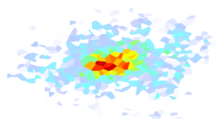2.1. Philosophy of Estimating and Interpolating Ground Motions¶
The overall strategy for the deployment of stations under the ANSS implementation plan relies on dense instrumentation concentrated in urban areas with high seismic hazards (USGS, 1999) and fewer stations in outlying areas. Based on this philosophy, and when fully deployed, maps generated in these urban regions are expected to be most accurate where the population at risk is the greatest, and therefore, where emergency response and recovery efforts will likely be most urgent and complex.
Even so, significant gaps in the observed shaking distribution will likely remain, especially in the transition from urban to more rural environments. Likewise, many critical facilities and lifelines are widely distributed, away from population centers and their dense seismic sensor networks. Thus, as a fundamental strategy for ShakeMap, we have developed algorithms to best describe the shaking in more remote areas by utilizing a variety of seismological tools. In addition to the areas without sufficient instrumentation where we would like to estimate motions to help assess the situation, and as a fail-safe backup, it is also useful to have these algorithms in place in the event of potential communication dropout from a portion of the network. The same tools are, in fact, beneficial for interpolating between observations (i.e., seismic stations) even within densely instrumented portions of the networks.
If there were stations at each of the tens of thousands of map grid points needed to adequately portray shaking, then the creation of shaking maps would be relatively simple. Of course, stations are not available for the overwhelming majority of these grid points, and in many cases grid points may be tens of kilometers or more from the nearest reporting station. The overall mapping philosophy is then to combine information from individual stations, site amplification characteristics, and ground-motion prediction equations for the distance to the hypocenter (or to the causative fault) to create the best composite map. The procedure should produce reasonable estimates at grid points located far from available data while preserving the detailed shaking information available for regions where there are stations nearby.
It should be mentioned that mathematically, or algorithmically, geospatial interpolation can take many forms. There are some good reasons to employ geospatial kriging-with-a-trend kriging-with-a-trend. However, the complexity of the trends (GMPE, as well as inter-event bias corrections per Intensity Measure or IM), the use of multiply-weighted strong-motion and macroseimic data, and the real-time nature of the processing require other considerations. The approach ShakeMap currently employs for interpolation (Worden et al., 2018) applies a conditional multi-variate normal distribution, within which some or all of the points upon which the distribution is conditioned may themselves have uncertainty. It remains to be seen to what extent this approach is analogous to kriging-with-a-trend mathematically.
Estimating motions where there are few stations, and then interpolating the recordings and estimates to a fine grid for mapping and contouring, requires several steps. In the following sections, we describe the process from input to final interpolated grid.
